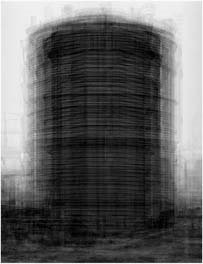 When photos from a thematic set are superimposed on top of each other, the result is a kind of archetype. This procedure has long been used to study the human face. For example, in the 1930s, the magazine Vanity Fair superimposed headshots of then-popular movie stars to yield averaged versions of male and female beauty. (The male ideal came out looking rather feminine. Oh my!)
When photos from a thematic set are superimposed on top of each other, the result is a kind of archetype. This procedure has long been used to study the human face. For example, in the 1930s, the magazine Vanity Fair superimposed headshots of then-popular movie stars to yield averaged versions of male and female beauty. (The male ideal came out looking rather feminine. Oh my!)More recently, facial averaging has been used as a tool for scientific research. For example, it plays a role in the development of face recognition software. And it has been used to study the biological basis of beauty. Judith Langlois at the University of Texas, Austin, has been a leader in this area. Her lab has a website that describes the research. I have borrowed the averaged male face shown at the top from the website of another researcher in this field, Dr. Martin Gruendl of the University of Regensburg (Germany).
 What has been done for faces can be done for artworks. The upcoming show at Fraenkel Gallery features the work of Idris Khan, a young British artist who has been making composites of series of artworks. One set, featured on the show card, is “every…William Turner Postcard from the Tate Britain, 2004.” Khan has also done composites of photographic series by Bernd and Hilla Becher. The example shown above (from the gallery website) brings to mind the chalk drawings of Gary Simmons. This should be an interesting show. There is a reception on Thursday, May 4th, from 5:30 to 7:30 pm. The gallery is located at 49 Geary St., San Francisco.
What has been done for faces can be done for artworks. The upcoming show at Fraenkel Gallery features the work of Idris Khan, a young British artist who has been making composites of series of artworks. One set, featured on the show card, is “every…William Turner Postcard from the Tate Britain, 2004.” Khan has also done composites of photographic series by Bernd and Hilla Becher. The example shown above (from the gallery website) brings to mind the chalk drawings of Gary Simmons. This should be an interesting show. There is a reception on Thursday, May 4th, from 5:30 to 7:30 pm. The gallery is located at 49 Geary St., San Francisco.Also this week, Intersection for the Arts is mounting an exhibit by Binh Danh and Elizabeth Moy called “Disrupted: A Photographic Installation About Memory, History, & War.” Binh Danh is noted for his chlorophyll prints—photographic images on leaves. There is a reception on Wednesday, May 3rd, from 6:00 to 9:00 pm.

No comments:
Post a Comment